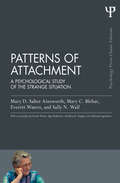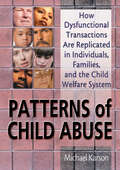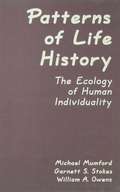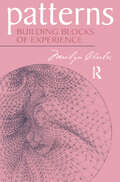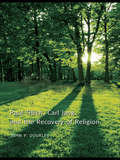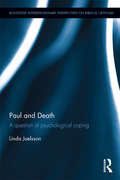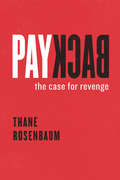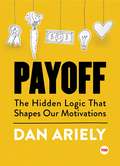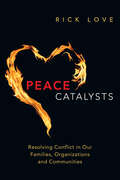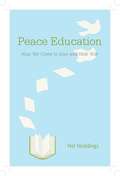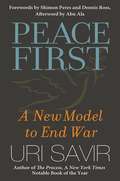- Table View
- List View
Patterns of Attachment: A Psychological Study of the Strange Situation (Psychology Press & Routledge Classic Editions)
by Mary C. Blehar Everett Waters Mary D. Ainsworth Sally N. WallEthological attachment theory is a landmark of 20th century social and behavioral sciences theory and research. This new paradigm for understanding primary relationships across the lifespan evolved from John Bowlby’s critique of psychoanalytic drive theory and his own clinical observations, supplemented by his knowledge of fields as diverse as primate ethology, control systems theory, and cognitive psychology. By the time he had written the first volume of his classic Attachment and Loss trilogy, Mary D. Salter Ainsworth’s naturalistic observations in Uganda and Baltimore, and her theoretical and descriptive insights about maternal care and the secure base phenomenon had become integral to attachment theory. Patterns of Attachment reports the methods and key results of Ainsworth’s landmark Baltimore Longitudinal Study. Following upon her naturalistic home observations in Uganda, the Baltimore project yielded a wealth of enduring, benchmark results on the nature of the child’s tie to its primary caregiver and the importance of early experience. It also addressed a wide range of conceptual and methodological issues common to many developmental and longitudinal projects, especially issues of age appropriate assessment, quantifying behavior, and comprehending individual differences. In addition, Ainsworth and her students broke new ground, clarifying and defining new concepts, demonstrating the value of the ethological methods and insights about behavior. Today, as we enter the fourth generation of attachment study, we have a rich and growing catalogue of behavioral and narrative approaches to measuring attachment from infancy to adulthood. Each of them has roots in the Strange Situation and the secure base concept presented in Patterns of Attachment. It inclusion in the Psychology Press Classic Editions series reflects Patterns of Attachment’s continuing significance and insures its availability to new generations of students, researchers, and clinicians.
Patterns of Attachment: A Psychological Study of the Strange Situation (Psychology Press And Routledge Classic Editions Ser.)
by M. D.S. Ainsworth M. C. Blehar E. Waters S. WallFirst published in 1979. Ethological attachment theory is a landmark of 20th century social and behavioral sciences theory and research. This new paradigm for understanding primary relationships across the lifespan evolved from John Bowlby's critique of psychoanalytic drive theory and his own clinical observations, supplemented by his knowledge of fields as diverse as primate ethology, control systems theory, and cognitive psychology. By the time he had written the first volume of his classic Attachment and Loss trilogy, Mary D. Salter Ainsworth's naturalistic observations in Uganda and Baltimore, and her theoretical and descriptive insights about maternal care and the secure base phenomenon had become integral to attachment theory. Patterns of Attachment reports the methods and key results of Ainsworth's landmark Baltimore Longitudinal Study. Following upon her naturalistic home observations in Uganda, the Baltimore project yielded a wealth of enduring, benchmark results on the nature of the child's tie to its primary caregiver and the importance of early experience. It also addressed a wide range of conceptual and methodological issues common to many developmental and longitudinal projects, especially issues of age appropriate assessment, quantifying behavior, and comprehending individual differences. In addition, Ainsworth and her students broke new ground, clarifying and defining new concepts, demonstrating the value of the ethological methods and insights about behavior. Today, as we enter the fourth generation of attachment study, we have a rich and growing catalogue of behavioral and narrative approaches to measuring attachment from infancy to adulthood. Each of them has roots in the Strange Situation and the secure base concept presented in Patterns of Attachment. It inclusion in the Psychology Press Classic Editions series reflects Patterns of Attachment's continuing significance and insures its availability to new generations of students, researchers, and clinicians.
Patterns of Child Abuse: How Dysfunctional Transactions Are Replicated in Individuals, Families, and the Child Welfare System
by Michael Karson Elizabeth SparksInterpret the hidden meaning of family roles to help children at risk!Because dysfunctional patterns are closed systems that serve a secret purpose, they are almost impossible to change from the outside. Patterns of Child Abuse helps you recognize the purpose behind the patterns and offers successful strategies for entering the pattern in order to help family members without joining it and becoming part of the dysfunction. Patterns of Child Abuse identifies the most common, most problematic patterns and explores their hidden meanings. Case studies and theoretical discussions demonstrate the ways family patterns are replicated in a child's psyche and the ways the grown-up child replicates the familiar family pattern, forcing the world to bend to the story within. Synthesizing systems theory, behaviorism, and psychoanalysis, Patterns of Child Abuse offers powerful insights as well as practical strategies for dealing with such complex issues as: how to comfort an abused child who cannot bear to be touched why abused children idealize their battering or neglectful parent how borderline personality organization affects individuals and their families handling the sexually powerful teenage girl, the disruptive boy, and the mother of the sexual abuse victim how family patterns operate in therapeutic context why therapists and social workers may encounter conflicts in child welfare cases when and how paradoxical interventions can work Well-written and insightful, Patterns of Child Abuse conveys a sound theoretical model and a sophisticated approach to the psychology of individuals and families for the child welfare professional.
Patterns of Intuition
by Gerhard NierhausThe present book is the result of a three year research project which investigated the creative act of composing by means of algorithmic composition. Central to the investigation are the compositional strategies of 12 composers, which were documented through a dialogic and cyclic process of modelling and evaluating musical materials. The aesthetic premises and compositional approaches configure a rich spectrum of diverse positions, which is reflected also in the kinds of approaches and methods used. These approaches and methods include the generation and evaluation of chord sequences using genetic algorithms, the application of morphing strategies to research harmonic transformations, an automatic classification of personal preferences via machine learning, and an application of mathematical music theory to the analysis and resynthesis of musical material. The second part of the book features contributions by Sandeep Bhagwati, William Brooks, David Cope, Darla Crispin, Nicolas Donin, and Guerino Mazzola. These authors variously consider the project from different perspectives, offer independent approaches, or provide more general reflections from their respective research fields.
Patterns of Life History: The Ecology of Human Individuality (Applied Psychology Series)
by William A. Owens Michael D. Mumford Garnett S. Stokes Garnett StokesThis work summarizes an ongoing longitudinal study concerned with the nature of human differences as manifest in peoples' life histories. The traditional models for the description of human differences are reviewed, then contrasted with the presentation of alternative models. This volume is also one of the few to investigate different approaches to measurement procedures. Practical applications of these models and the results obtained in a 23 research effort are discussed.
Patterns: Building Blocks of Experience
by Marilyn CharlesIn recent years, various tributaries of psychoanalytic and developmental theory have flowed into our dawning understanding of the role of early sensory and affective experiences in the construction of our personal worlds. In Patterns: Building Blocks of Experience, Marilyn Charles shows how such primary experiences coalesce into patterns, those essential units of meaning that capture the unique subjectivity of each individual. Frequently "known" by their prosody or affective melody, patterns come to have profound meanings that we utilize in constructing basic notions of self and other. Through pattern, Charles holds, we approach elusive meanings through dimensions of shape, contour, and affective resonance. Such patterned understandings, in turn, become a mode of interchange through which we touch one another in ways that go beyond the overtly physical. Analytic patients, Charles finds, have often led early lives too full of "noise" to use their early sensory and affective experiences constructively. Such patients tend to live out patterns that operate unconsciously and have become literally incomprehensible. Analytic communication, by drawing explicit attention to such patterned experience, provides new images that intrude on ingrained patterns of thinking about the self and other. Out of the productive clash of analytically co-constructed images and the invariant patterns of the past emerge new conceptions of what the patient may choose to be in the present moment. Through it all, Charles displays an admirable willingness to sit in difficult spaces and to work through troubling therapeutic impasses from the inside out, rather than from some point of ostensible safety. This finely textured and richly evocative study, which grows out of Charles' extensive clinical work with artists, writers, and musicians, is a signal contribution to developmental theory, clinical theory, and the psychology of creativity.
Paul McCartney and His Creative Practice: The Beatles and Beyond (Palgrave Studies in Creativity and Culture)
by Paul Thompson Phillip McIntyreThis book provides fresh insight into the creative practice developed by Paul McCartney over his extended career as a songwriter, record producer and performing musician. It frames its examination of McCartney’s work through the lens of the systems model of creativity developed by Mihaly Csikszentmihalyi and combines this with the research work of Pierre Bourdieu. This systems approach is built around the basic structures of idiosyncratic agents, like McCartney himself, and the choices he has made as a creative individual. It also locates his work within social fields and cultural domains, all crucial aspects of the creative system that McCartney continues to be immersed in. Using this tripartite system, the book includes analysis of McCartney’s creative collaborations with musicians, producers, artists and filmmakers and provides a critical analysis of the Romantic myth which forms a central tenet of popular music. This engaging work will have interdisciplinary appeal to students and scholars of the psychology of creativity, popular music, sociology and cultural studies.
Paul Tillich, Carl Jung and the Recovery of Religion
by John P. DourleyIs religion a positive reality in your life? If not, have you lost anything by forfeiting this dimension of your humanity? This book compares the theology of Tillich with the psychology of Jung, arguing that they were both concerned with the recovery of a valid religious sense for contemporary culture. Paul Tillich, Carl Jung and the Recovery of Religion explores in detail the diminution of the human spirit through the loss of its contact with its native religious depths, a problem on which both spent much of their working lives and energies. Both Tillich and Jung work with a naturalism that grounds all religion on processes native to the human being. Tillich does this in his efforts to recover that point at which divinity and humanity coincide and from which they differentiate. Jung does this by identifying the archetypal unconscious as the source of all religions now working toward a religious sentiment of more universal sympathy. This book identifies the dependence of both on German mysticism as a common ancestry and concludes with a reflection on how their joint perspective might affect religious education and the relation of religion to science and technology. Throughout the book, John Dourley looks back to the roots of both men's ideas about mediaeval theology and Christian mysticism making it ideal reading for analysts and academics in the fields of Jungian and religious studies.
Paul Vitz: Psychological Mythbuster
by Wanda SkowronskaAmerican psychologist, Paul Vitz, was a pioneer critic of the ‘me, me, me’ generation and humanistic psychology which flourished alongside it. He stands out because of the cultural, psychological and spiritual depth of his critique. Mythbusters are rare and Vitz is a mythbuster par excellence, tearing apart several generations of selfism with insight, wisdom and wit. Other critiques came much later. He saw it all at the time. This book takes the reader on a journey into the life and thought of a rare thinker, a questioner of ideological sacred cows, and one of the most original and gifted psychologists of the past century. PAUL VITZ WAS A VISIONARY FOR HIS TIME IN CONFRONTING AND MYTHBUSTING HUMANISTIC PSYCHOLOGY AMIDST ‘A TSUNAMI OF HUMANISTIC ADULATION.’ THIS BOOK GIVES PERCEPTIVE INSIGHTS INTO VITZ'S THOUGHT AND TIMES. WELL WORTH READING! – Catherine MacLaurin, Psychologist, Senior Wellbeing Advisor (SWA), Health and Safety Directorate, NSW Department of Education and Training, Australia THE AMERICAN PSYCHOLOGIST, PAUL VITZ, HAS BEEN A REMARKABLY PRESCIENT AND COURAGEOUS CRITIC OF THE HUMANIST PSYCHOLOGY MOVEMENT, HEADLINED BY CARL ROGERS. IN THIS BOOK, WANDA SKOWRONSKA HAS PROVIDED A THOROUGH AND CONVINCING ACCOUNT OF VITZ’S WORK. HER BOOK DESERVES A WIDE READERSHIP. – Colin Patterson STD, Dean and Permanent Fellow of the former John Paul II Institute, Melbourne, Australia. IN HER BOOK, WANDA SKOWRONSKA MASTERFULLY NARRATES THE PHILOSOPHICAL, THEOLOGICAL, AND HISTORICAL CONTEXT OF THE DEVELOPMENT OF HUMANISTIC PSYCHOLOGY, ESPECIALLY THAT OF CARL ROGERS, THROUGH THE LENS OF PAUL C. VITZ’S LIFE AND PUBLICATIONS. THIS WORK CRITIQUES THE INFLUENCES OF CONTEMPORARY PSYCHOLOGY’S HUMANISTIC ORIGINS OF SELF-FULFILMENT THEORIES AND CULTURAL MARXISM AND HONOURS THE LIFELONG WORK OF PAUL VITZ, WHO IS UNDOUBTEDLY ONE OF THE MOST SIGNIFICANT CATHOLIC PSYCHOLOGISTS OF OUR TIMES. – Professor Craig Steven Titus, S.Th [http://s.th/].D./Ph.D. Divine Word University, USA.
Paul and Death: A Question of Psychological Coping (Routledge Interdisciplinary Perspectives on Biblical Criticism)
by Linda JoelssonThe concept of death, particularly violent death, is prevalent throughout the writings of Paul the Apostle. His letters in the New Testament address this topic from a variety of perspectives, some of which can appear to be almost contradictory. However, this need not be problematic. Paul and Death uses the method of psychological exegesis to show that the different attitudes toward death in Paul’s letters make for a much more coherent discourse if they are seen as an aid to individual and collective psychological coping. Taking the differences between each of Paul’s letters as its starting point, this study suggests that a variety of coping strategies in relation to death may be beneficial depending on the situation, the person, and the stage of the coping process. Drawing on psychologically-oriented hermeneutic theory, and theories about psychological coping in particular, the author argues that each case of psychological coping must be understood in its historical situation, and as strategies emanating from a specific person’s subjective appraisal. Combining theology and biblical studies with modern psychology, this book will be of particular interest to academics and students that are studying the relationship between Religion and notions of Death.
Paul's Prayers: A Mother's Account of Raising an Autistic Son
by Susan AndersonRecipient of the Catholic Writers Guild 2018 Seal of Approval“A journey of compassion, frustration, and triumph . . . Anderson’s love for her son marks this beautiful portrait of family and faith.” —Publishers WeeklyPaul's Prayers is the story of a moderately autistic young man navigating life with a spiritual intelligence that runs further than most people can walk. Written by Paul's mother, this insightful memoir gives readers a unique look at the challenges and joys of raising her autistic son in a large Catholic family. The first of six children, Paul's early years were an exciting and confusing time for his parents. At the time, very little information on autism and its early signs was available, and the fact that the disorder is a spectrum ranging from mild to severe was not widely known. Unpredictable outbursts and sensitivities to light and schedule disruptions lead Paul's parents to refer to his condition as "The Marauder." The Marauder sweeps over the hospital nursery as the fluorescent lights blind Paul's eyes. The Marauder throws his black cape over the Christmas holidays, stealing four-year-old Paul's speech for three long days. In school, The Marauder keeps other students at bay, leaving Paul isolated and alone. Finally a developmental assessment gives some clarity to the exhausted family: Paul is on the autism spectrum, and they will all have to adjust their perspectives. Small victories emerge as Paul begins to reach developmental milestones in creative ways. Six years of piano lessons lead to a dramatic improvement in reading skills. A jaunt through the mountains with his father introduces Paul to his talent for running; with his brothers, he joins the high school cross country running team, which goes on to win the state championship. After high school, Paul works for the family business and attends college. Throughout this intimate memoir, every day is a challenge to be met with creative thinking, patience, and faith. Paul finds comfort in contemplative prayer and the support of his family when the world around him becomes too chaotic. As her son grows up, Susan Anderson learns how to cope with autism and embrace the importance of faith in the things unseen. Her family's experience is a beacon of light for those who find themselves on a similar path.
Pauli and Jung
by Markus Fierz David LindorffNobel prize-winning atomic physicist Wolfgang Pauli experienced a moral crisis over what he called the "dark side of science,"shortly after his 1932 prediction of the existence of the neutrino, a particle of cosmic importance to physics. Located at the Institute for Advanced Study in Princeton during the Manhattan Project-the initiative which drew scientific luminaries like Robert Oppenheimer to oversee the development of the atomic bomb-Pauli was curiously withdrawn, alienated by the military's increasing influence over the pursuit of science.Following the bombings of Hiroshima and Nagasaki, Pauli's dreams illuminated his primary concern, what he termed the "psycho-physical problem," or the need for science to become morally accountable by considering "irrational phenomena." This dilemma led Pauli to the prominent depth psychologist C.G. Jung, whose own pioneering theory of synchronicity posited coincidence as a reliable supplement to rational thought. Over the next twenty years, the two great thinkers exchanged letters detailing their philosophical differences regarding the psycho-physical problem, Pauli's dreams and the symbolic relation of psyche and matter at the archetypal level.Author David Lindorff supplements the remarkable letters Pauli and Jung exchanged with his own insightful interpretation. By illustrating how Pauli's dreams complemented and informed his groundbreaking ideas, Lindorff skillfully supports both Pauli and Jung's perspectives of reality and suggests the dire importance of unifying the rational scientific approach of physics with the irrational influence of the unconscious.
Pauli and Jung
by Markus Fierz David LindorffThe pioneering work of Nobel prize-winning physicist Wolfgang Pauli led to developing the bombs that decimated Hiroshima and Nagasaki. Desperate over this outcome, Pauli sought help from the eminent depth psychologist, C. G. Jung. Their long correspondence provides the powerful and unique record of a mature scientist's inner journey. It also has had a tremendous impact on scientific and psychological thought ever since. Pauli and Jung is a lucid interpretation of Pauli's ideas and dreams that forcefully validates his belief in the inseparable union of science and spirituality. Far ahead of their time, Wolfgang Pauli and C. G. Jung both knew this union is essential for the future of humanity and the survival of the planet.
Pavlovian Second-Order Conditioning: Studies in Associative Learning (Psychology Revivals)
by Robert A. RescorlaOriginally published in 1980, this volume explores some of the dramatic and exciting changes that had taken place in the field of conditioning in the 15 years prior to publication. The usefulness of a particular learning procedure, second-order conditioning, is explored in three aspects of the learning process: (1) the measurement of learning; (2) the circumstances that produce associative learning; and (3) the content of that learning. The usefulness of this new paradigm is documented with the results of experiments that had grown out of the author’s programmatic work at the time. Completely new results were published for the first time, in an attempt to demonstrate the power of this particular learning procedure in elucidating fundamental questions about the nature of learning.
Payback: The Case for Revenge
by Thane RosenbaumWe call it justice—the assassination of Osama bin Laden, the incarceration of corrupt politicians or financiers like Rod Blagojevich and Bernard Madoff, and the climactic slaying of cinema-screen villains by superheroes. But could we not also call it revenge? We are told that revenge is uncivilized and immoral, an impulse that individuals and societies should actively repress and replace with the order and codes of courtroom justice. What, if anything, distinguishes punishment at the hands of the government from a victim’s individual desire for retribution? Are vengeance and justice really so very different? No, answers legal scholar and novelist Thane Rosenbaum in Payback: The Case for Revenge—revenge is, in fact, indistinguishable from justice. Revenge, Rosenbaum argues, is not the problem. It is, in fact, a perfectly healthy emotion. Instead, the problem is the inadequacy of lawful outlets through which to express it. He mounts a case for legal systems to punish the guilty commensurate with their crimes as part of a societal moral duty to satisfy the needs of victims to feel avenged. Indeed, the legal system would better serve the public if it gave victims the sense that vengeance was being done on their behalf. Drawing on a wide range of support, from recent studies in behavioral psychology and neuroeconomics, to stories of vengeance and justice denied, to revenge practices from around the world, to the way in which revenge tales have permeated popular culture—including Hamlet, The Godfather, and Braveheart—Rosenbaum demonstrates that vengeance needs to be more openly and honestly discussed and lawfully practiced. Fiercely argued and highly engaging, Payback is a provocative and eye-opening cultural tour of revenge and its rewards—from Shakespeare to The Sopranos. It liberates revenge from its social stigma and proves that vengeance is indeed ours, a perfectly human and acceptable response to moral injury. Rosenbaum deftly persuades us to reconsider a misunderstood subject and, along the way, reinvigorates the debate on the shape of justice in the modern world.
Payoff: The Hidden Logic That Shapes Our Motivations (TED Books)
by Dan ArielyBestselling author Dan Ariely reveals fascinating new insights into motivation—showing that the subject is far more complex than we ever imagined.Every day we work hard to motivate ourselves, the people we live with, the people who work for and do business with us. In this way, much of what we do can be defined as being “motivators.” From the boardroom to the living room, our role as motivators is complex, and the more we try to motivate partners and children, friends and coworkers, the clearer it becomes that the story of motivation is far more intricate and fascinating than we’ve assumed. Payoff investigates the true nature of motivation, our partial blindness to the way it works, and how we can bridge this gap. With studies that range from Intel to a kindergarten classroom, Ariely digs deep to find the root of motivation—how it works and how we can use this knowledge to approach important choices in our own lives. Along the way, he explores intriguing questions such as: Can giving employees bonuses harm productivity? Why is trust so crucial for successful motivation? What are our misconceptions about how to value our work? How does your sense of your mortality impact your motivation?
Peace
by David CortrightVeteran scholar and peace activist David Cortright offers a definitive history of the human striving for peace and an analysis of its religious and intellectual roots. This authoritative, balanced, and highly readable volume traces the rise of peace advocacy and internationalism from their origins in earlier centuries through the mass movements of recent decades: the pacifist campaigns of the 1930s, the Vietnam antiwar movement, and the waves of disarmament activism that peaked in the 1980s. Also explored are the underlying principles of peace - nonviolence, democracy, social justice, and human rights - all placed within a framework of 'realistic pacifism'. Peace brings the story up-to-date by examining opposition to the Iraq War and responses to the so-called 'war on terror'. This is history with a modern twist, set in the context of current debates about 'the responsibility to protect', nuclear proliferation, Darfur, and conflict transformation.
Peace Advocacy in the Shadow of War
by Francis ShorFor peace advocates a corollary to Clausewitz’s dictum that “war is politics by other means” might be that other politics could prevent war. By highlighting both individual peace advocates and antiwar/peace organizations from World War I through the wars of the 21st century, the chapters will provide insights into how these individuals and organizations articulated their opposition to and mobilized against specific wars and international/regional conflicts. Organized roughly in chronological order, each chapter will illuminate the socio-historical conditions under which such peace advocacy contested state aggression and armed combat at the national and/or transnational levels. Beyond understanding the specific socio-historical circumstances within which these antiwar and peace advocates and organizations operated and their resultant achievements and failures, the book as a whole will examine the kind of politics that perpetuate war and those that offer a challenge to that perpetuation. Scholars, students, and the general public interested in the history of modern and contemporary wars, peace and conflict studies, and ethical/political perspectives in the 20th and 21st centuries should find much to reflect upon in this book.
Peace Begins in the Soul: Family Constellations in the Service of Reconciliation
by Bert Hellinger Colleen BeaumontIn family constellations, the work of reconciliation begins in the individual soul and in the family. When reconciliation is achieved there, it can spread to larger groups and contexts. In this book, Bert Hellinger inquires into the emotional prerequisites that are necessary for peace and reconciliation. He finds answers in examples from historic conflicts between peoples and cultures. But Hellinger also devotes himself to peace among religions, for example, between Christianity and Islam, as well as to peace between victors and vanquished in the Spanish Conquest, and between masters and slaves in Brazil or the United States.
Peace Building Through Women’s Health: Psychoanalytic, Sociopsychological, and Community Perspectives on the Israeli-Palestinian Conflict (Psychoanalytic Inquiry Book Series)
by Norbert GoldfieldThis book is an examination of the Israeli-Palestinian conflict through psychoanalytic, sociopsychological, and nationalistic lenses, highlighting the successes and the hurdles faced by one organization, Healing Across the Divides (HATD), in its mission to measurably improve health in marginalized populations of both Israelis and Palestinians. Peace Building through Women’s Health begins with a summary of the "peace building through health" field and a psychoanalytic, sociopsychological examination of the Israeli-Palestinian conflict. After a series of informative case studies, the book concludes with an analysis of how this organization has evolved its "peace building through health" approach over the fifteen years since its founding. Working with community groups, HATD has measurably improved the lives of more than 200,000 marginalized Israelis and Palestinians. In the process, it also improves the effectiveness of the community group grantees, by offering experienced management consulting and by requiring rigorous ongoing self-assessment on the part of the groups. IHATD hopes that, in the long term, some of the community leaders it supports will be tomorrow’s political leaders. As these leaders strengthen their own capabilities, they will be able to increasingly contribute to securing peace in one of the longest running conflicts in the world today. Peace Building through Women’s Health will be invaluable to public and mental health professionals interested in international health, peace and conflict studies, and conflict resolution.
Peace Catalysts: Resolving Conflict in Our Families, Organizations and Communities
by Rick Love"If it is possible, as far as it depends on you, live at peace with everyone." —Romans 12:18 Conflict happens. It's a painful reality of life in a fallen world. But we don't need to be content with broken relationships—conflict resolution is possible. God's intention for us and for the world is for all to live in peace with one another, and Christian peacemakers have an unparalleled opportunity to be true ambassadors of reconciliation. Rick Love, founder and president of Peace Catalyst International, shares the principles that have guided his peacemaking efforts around the world. Masterfully blending Scripture and personal experience, he provides a biblical framework for how the God of peace seeks restoration for all who experience conflict—in the home and workplace and even across international borders. With the life of Jesus as the prime example, Love equips and empowers peacemakers of all stripes to integrate evangelical witness with commitment to reconciliation. We can walk in the footsteps of Jesus as catalysts of peace, bringing transformation and hope to a world crying out for healing and forgiveness.
Peace Education: How We Come to Love and Hate War
by Nel NoddingsThere is a huge volume of work on war and its causes, most of which treats its political and economic roots. In Peace Education: How We Come to Love and Hate War, Nel Noddings explores the psychological factors that support war: nationalism, hatred, delight in spectacles, masculinity, religious extremism and the search for existential meaning. She argues that while schools can do little to reduce the economic and political causes, they can do much to moderate the psychological factors that promote violence by helping students understand the forces that manipulate them.
Peace Education: The Concept, Principles, and Practices Around the World
by Gavriel Salomon Baruch NevoPeace Education: * presents views on the nature of peace education, its history, and relationships to neighboring fields; * examines relevant psychological and pedagogical principles, such as the contact experience, conciliation through personal story telling, reckoning with traumatic memories, body-work, and the socio-emotional aspects of reconciliation; and * introduces an array of international examples from countries, such as Croatia, Northern Ireland, Israel, South Africa, Rwanda, and the United States in order to generalize lessons learned. A "must have" for all those thinking, planning, conducting, and studying peace education programs, it is intended for scholars, students, and researchers interested in peace and conflict resolution in higher education and volunteer and public organizations. Its cross disciplinary approach will appeal to those in social and political psychology, communication, education, religion, political science, sociology, and philosophy.
Peace First: A New Model to End War
by Uri SavirPeace First draws on Savir's own deep, first-hand experiences from the Oslo Peace Process, as well as his peace-building efforts between enemies and former enemies in the African nations of Ethiopia, Eritrea, Rwanda, and Sierra Leone.
Peace Psychology and Character Strengths: Integrating Science and Practice (Peace Psychology Book Series)
by Ryan M. NiemiecIn this volume the sciences of peace psychology and character strengths integrate in a substantive way to examine how the positive parts of our personality can contribute and impact each “level” of peace - inner, relational, group, community, international, and ecological peace. Readers will discover a wide range of insights, models, and scholarship; new studies conducted for this volume; and practical strategies to bring greater peace to oneself, one’s relationships, and the world.
